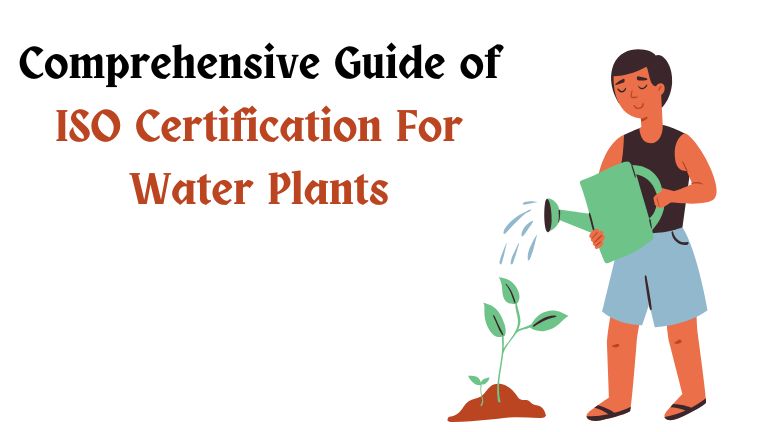The water industry is central to public health and
environmental sustainability, and its management requires strict adherence to
quality, safety, and environmental standards. One of the most effective ways
for water treatment plants, bottling plants, and other water-related facilities
to ensure compliance and demonstrate their commitment to high standards is
through ISO certification. ISO (International Organization for Standardization)
provides a range of standards that help industries meet regulatory and customer
requirements, improve efficiency, and foster trust.
In this article, we’ll explore the significance of ISO
certification for water plants, the different types of ISO standards applicable,
the benefits of certification, and a step-by-step guide to achieving it.
Why ISO
Certification is Essential for Water Plants
Water plants play a crucial role in delivering safe and
clean water for consumption, agriculture, and industrial use. Contamination or
failure in water systems can lead to severe health risks, environmental
degradation, and loss of public trust. ISO certification serves as a benchmark
for quality, safety, and environmental management within the water industry,
offering multiple benefits:
- Quality Assurance: ISO standards set stringent guidelines that help
ensure that water plants consistently deliver high-quality services and
products.
- Operational Efficiency: Adhering to ISO standards promotes
systematic practices that streamline processes, reduce waste, and optimize
resource utilization.
- Regulatory Compliance: ISO certification helps water plants align
with local, national, and international regulations, reducing the risk of
penalties and shutdowns.
- Risk Management: ISO standards foster proactive risk management,
ensuring plants are equipped to handle potential threats such as contamination
or equipment failures.
- Enhanced Customer Trust: An ISO-certified water plant signals
reliability, which can improve customer and stakeholder confidence in its
services.
Key ISO Standards for Water Plants
Several ISO standards apply to different aspects of water
plant operations. Here are the primary ones that can benefit the water
industry:
ISO 9001: Quality
Management System
ISO 9001 is one of the most widely adopted standards and is
critical for ensuring quality across all processes. For water plants, this
standard helps set up a Quality Management System (QMS) that governs
operational procedures, documentation, and customer focus.
- Core Requirements: Process
control, continuous improvement, and customer satisfaction.
- Benefits: Improved efficiency,
reduced operational errors, and enhanced customer satisfaction.
ISO 14001:
Environmental Management System
Water plants have significant environmental
responsibilities, as they handle a vital natural resource. ISO 14001 focuses on
establishing an Environmental Management System (EMS), guiding plants in
managing their impact on the environment, reducing waste, and adhering to
environmental regulations.
- Core Requirements: Environmental impact
assessments, waste reduction, and resource conservation.
- Benefits: Minimized environmental footprint,
better compliance with environmental laws, and improved community reputation.
ISO 22000: Food
Safety Management System (For Bottled Water Plants)
For bottled water plants, ISO 22000 is particularly relevant
as it outlines standards for food safety management. Water bottling is
considered part of the food industry, and ISO 22000 sets guidelines to help avoid
contamination and ensure the highest safety standards
- Core Requirements: Hazard
analysis, food safety planning, and control of food safety hazards.
- Benefits: Assured
safety of bottled water, reduced risk of contamination, and compliance with
food safety regulations
ISO 45001:
Occupational Health and Safety Management System
Water plants can pose significant occupational hazards for
employees. ISO 45001 helps create a safer working environment by implementing a
Health and Safety Management System (HSMS) to identify and mitigate workplace
risks, ensuring employee safety.
- Core Requirements: Risk
assessment, emergency preparedness, and incident management.
- Benefits: Reduced workplace
incidents, improved employee morale, and compliance with occupational health
regulations.
Benefits of ISO
Certification for Water Plants
ISO certification for water plants brings several
substantial advantages, including:
- Improved Efficiency and Cost Savings: ISO standards streamline processes, which can lead to reduced costs by minimizing waste and improving operational efficiency.
- Enhanced Product and Service Quality: By following ISO guidelines, water plants can ensure higher and more consistent quality of water, thereby reducing complaints and increasing customer satisfaction.
- Reduced Environmental Impact: ISO 14001 certification encourages sustainable practices that conserve resources and reduce waste, helping plants contribute positively to the environment.
- Better Risk Management: Implementing ISO standards reduces the likelihood of accidents, contamination, and other operational risks, thereby protecting both the plant and the public.
- Compliance with Regulatory Standards: ISO standards align closely with many regulatory requirements, making it easier for water plants to remain compliant and avoid legal issues.
- Market Access and Competitive Advantage: ISO certification is often a prerequisite for bidding on certain contracts or partnering with high-profile clients. It can also differentiate a water plant from competitors.
Steps to Achieve ISO
Certification for Water Plants
Achieving ISO certification involves a series of
well-defined steps. Here’s a step-by-step guide to help water plants navigate
the certification process:
Step 1: Define
Objectives and Select the Right ISO Standards
The first step is to identify the standards most applicable
to the plant’s needs. For example, a treatment plant might focus on ISO 9001
and ISO 14001, while a bottling plant may also include ISO 22000 for food
safety.
Step 2: Develop and Implement
the Management Systems
Develop a tailored management system that complies with the
chosen ISO standards. This includes documentation of all procedures, policies,
and quality objectives. For example:
- A Quality Management System (QMS)
for ISO 9001 should define workflows for production, maintenance, and quality
checks
- An Environmental Management
System (EMS) for ISO 14001 should include waste management procedures,
pollution controls, and energy conservation methods.
Step 3: Conduct
Internal Training
ISO standards often require specific employee skills and
awareness. Conduct training sessions to educate employees on new protocols,
responsibilities, and ISO requirements.
Step 4: Perform
Internal Audits
Once systems are implemented, internal audits help assess
whether processes comply with ISO standards. This self-evaluation phase can
uncover areas for improvement before an external audit.
Step 5: Correct Non-Conformities
If non-conformities are identified, corrective actions
should be taken to ensure full compliance. Addressing these issues at this
stage ensures a smoother certification process.
Step 6: Choose a
Certification Body
Partner with an accredited certification body to initiate
the formal certification process. Selecting a reputable certification provider
is essential, as it ensures that the audit and certification are recognized
globally.
Step 7: External
Audit
The certification body conducts an external audit to
evaluate the management systems and ensure compliance with ISO standards. The
audit typically involves:
- Interviewing staff members to
verify compliance.
Step 8: Certification Decision and Continuous
Improvement
If the audit is successful, the certification body issues an
ISO certification. To maintain the certification, water plants must commit to
continuous improvement, regularly updating and refining processes to stay
compliant and effective.
Conclusion
ISO certification is an invaluable tool for water plants
looking to establish their credibility, ensure quality and safety, and minimize
their environmental impact. By adhering to standards like ISO 9001, ISO 14001,
ISO 22000, and ISO 45001, water plants can demonstrate their commitment to
excellence, protect public health, and contribute to sustainable water
management practices. The certification process requires investment in time,
training, and system development, but the long-term benefits—enhanced
reputation, operational efficiency, and customer trust—make it a wise and
essential endeavor for water plants aiming to excel in today’s regulated and
quality-conscious landscape.
Achieving ISO certification not only sets water plants on a
path to higher standards but also fosters a culture of continuous improvement,
ensuring that they can adapt to evolving industry demands and environmental
challenges.

